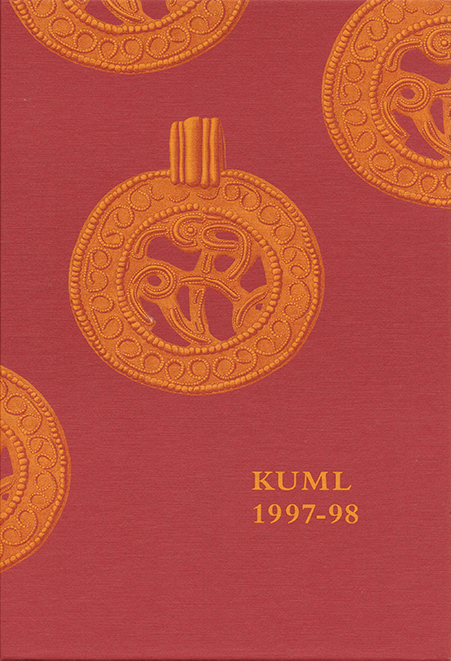A pendant related to the gold bracteates
DOI:
https://doi.org/10.7146/kuml.v41i41.113364Keywords:
Pendant, gold, bracteate, 6th centuryAbstract
A pendant related to the gold bracteates
In the late 1930s, a unique gold pendant from the period of the great migrations was found at Elbæk Skov, Husodde, on the northern side of Horsens Fjord (fig.1). Almost 60 years later, in the beginning of 1998, it was handed over to Forhistorisk Museum, Moesgård. (Fig.2)
The pendant is a thin golden plate with a loop. It weighs 2.8 grams and has a diameter of 2.2 cm. The plate has open-work ornament of a four-legged fabulous beast (fig. 3). A filigree pearl-pattern runs along the outer and inner edge of the border, and the border itself has a pretzel-shaped ornament made in a similar way. The animal motif is decorated with filigree, which gives it a relief effect similar to that on the various bracteate types.
The open-work pattern was probably made using a chisel from the back of the plate. The pendant has been repaired with a thin gold plate on the back, as the attachment for the border turned out to be too thin (fig.2). The loop has no visible wear but the filigree on the motif; the border and the edge are worn.
The style of the pendant from Elbæk Skov is similar to the animal style on the Dbracteates (fig. 4). The distribution map (fig. 5) shows finds of D-bracteates. It is worth noticing that no D-bracteates have been found on Zealand and the surrounding islands, or on Bornholm. A stylistic and chronological analysis has shown that the early types appear in Jutland. Later they are exported, copied and imitated outside Southern Scandinavia.
In Sweden one open-work pendant with a filigree animal figure has been found at Hylteberga in Scania (fig. 6) and another one at Skenäs in Södermanland (fig. 7). Comparing these with the Swedish neck collars from the 6th century, the Swedish pendants can be stylistically dated to the same time. The dating of the Elbæk Skov piece is based partly on the dating of the D-bracteates and partly on the animal ornamentation on the fibula from Skodborghus (fig. 8). On this basis the Elbæk Skov pendant is preliminarily dated to the early 6th century.
This dating relies on past archaeological interpretations. The author of this article holds a scholarship which will develop a new interpretation of the development and dating of the early animal style (Style I). The Elbæk Skov pendant is important to this chronology, as it connects the filigree pieces with the bracteates.
Elisabeth Barfod Carlsen
Downloads
Published
How to Cite
Issue
Section
License
Fra og med årgang 2022 er artikler udgivet i Kuml med en licens fra Creative Commons (CC BY-NC-SA 4.0).
Alle tidligere årgange af tidsskriftet er ikke udgivet med en licens fra Creative Commons.


